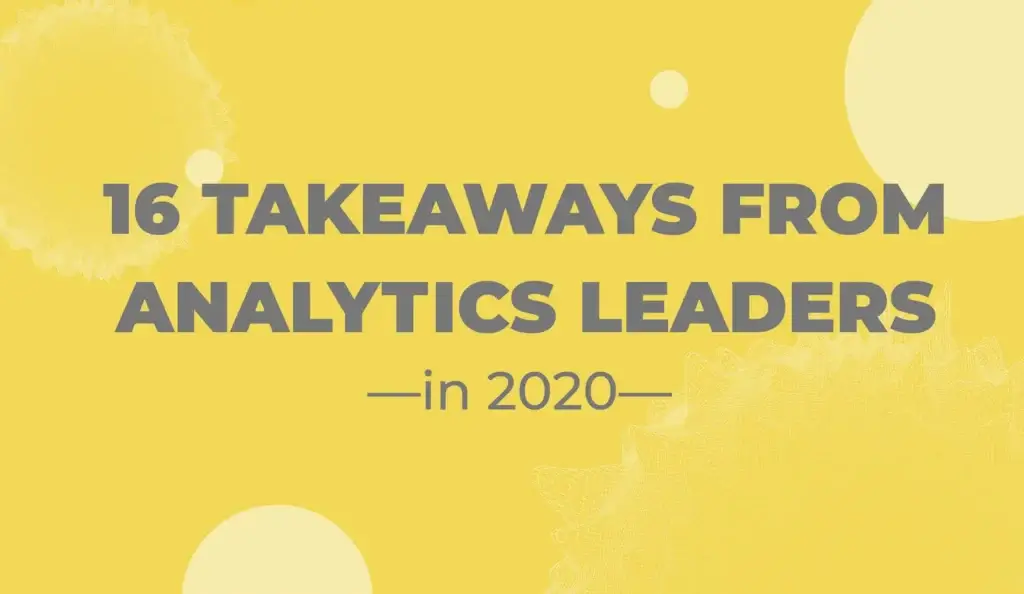The world of digital analytics is becoming increasingly complex. Rapid change in technology, knowledge, and data regulation has made getting a competitive advantage with digital analytics more challenging than ever.
As we work with companies to strengthen their tag governance, we see firsthand the many challenges associated with implementing, maintaining, and validating web, mobile, and app analytics implementations.
Because of these challenges, we decided to bring together some of the analytics industry’s brightest minds in our one-day, online Virtual Analytics Summit (VAS) to offer actionable tips and insights on improving and succeeding in your digital marketing efforts.
You can still watch the recorded Virtual Analytics Summit presentations on-demand. But in the meantime, continue reading to discover the top takeaways from all the presentations given at VAS.
Build a Robust Customer Data Strategy that Translates to Business Benefits
Tanu Javeri Sr. Global SEO Strategist, IBM
Too many teams get busy doing activities and forget to measure success or failure. Then they never build standards based on those successes and failures. As a result, it is essential to define, track and report the KPIs that compel organizations to take actual business actions.
Additionally, you need to understand what comprises good digital analytics. Good data begins with:
- Data Aggregation. Get data out of silos and into advanced tool-based analytics.
- Automation. A data-driven culture requires technology that can support efforts in exploiting data and analytics.
- Storytelling. Be effective by crafting captivating data-driven stories.
Then you need to uncover the intersection between the foundational metrics, the conversion metrics, and collateral gains (that we often forget to report on). The customer insights you get from maintaining accurate data will inform your marketing team on how to strengthen your value proposition for business priorities.
Creating a Data-Driven Culture Through Data Democratization
Erica Eischeid Analytics Consultant, Adobe
Foster a data-driven culture within your organization through a strong data democratization program. There are six key areas of data democratization:
- Tools and Infrastructure. Holistic and channel-specific analytics systems are defined, and tools are used in an advanced capacity.
- Data Delivery. Reports and dashboards are accessible by all users, and distribution is appropriately automated.
- Enablement & Communication. Proper training, tips & tricks, and new features are provided on a regular basis.
- Value Realization. Analytics data is traced back to company KPIs. Key business use cases, wins, and values realized are shared with leadership.
- User Administration & Access. Well-defined processes are in place to grant, review, and revoke user system and data access.
- Accountability. Solution ownership and leadership sponsors are defined.
A strong data democratization program ensures users have the access, knowledge, and tools available to make strategic, data-driven decisions that take their business to the next level.
Analytics is Not a Tool, But a Process
Simon Pilkoswki Global Lead Digital Performance Mgmt., Boehringer Ingelheim
You bought all the best analytics tools, but what if they aren’t delivering towards your expectations? Analytics is not a tool, but a process.
Managing analytics as a process for digital activation efforts can drive change within your organization. When you have the right technology stack at hand, and you combine it with effective processes, your business can benefit greatly.
To optimize your analytics processes you need to:
Plan your analytics process by:
- Defining your goals
- Setting up KPI hierarchies
- Determining an analytics framework
- Establishing a tagging plan
Execute your analytics process by:
- Having specialists deploy your analytics implementation
- Defining quality assurance parameters and values
- Optimizing and automating performance reporting
Utilize your analytics process by:
- Matching your analysis to company goals and going the extra mile to obtain useful insights
- Making data distribution a vital part of your communication efforts by inviting people to meetings and talking about data in cross-functional settings
- Converting insights into action and measuring your success with insights that have actually been implemented and have created beneficial change
It Takes a Village to Raise the Quality of Data
Jose Bergiste Director of Data & Analytics Engineering, Cognetik
Struggling with data quality? You’re not alone. A breakdown in communication between Analytics, QA, IT, or UX is a common cause. I’ve broken this issue down into six different pieces:
- Nuances of Accurate Data. Assume comparison between sources and aim for a consistent match instead of a perfect one.
- Why It Takes a Village. Specializations matter. When solving a complex problem, we must divide and conquer.
- Keys to Successful Team Coordination. Establish leadership and ownership via effective communication channels.
- Importance of Dynamic Documentation. It’s important to be clear the first time, but also every time!
- Importance of Evolving. Continually reflect, improve, and automate.
- Recognize Wins and Be Grateful. Celebrate your accomplishments, and don’t forget to say thank you!
Making data-driven decisions assumes having high-quality/accurate data. Low data quality is often directly correlated with low-quality communication between people and teams.
Creating a Better Digital World Starts with Accurate Data
John Pestana CEO and Co-Founder, ObservePoint
There is a lot of buzz in the industry about creating amazing digital experiences, but oftentimes, data professionals are so wrapped up in their day-to-day jobs that they forget why they’re ultimately collecting, cleansing, reporting, and analyzing on analytics data—to create these experiences and connect with their audiences.
The core way of gaining customer understanding to drive experiences comes from the data being collected by your analytics and marketing technologies. But with such frequent updates to your digital properties and with so many different teams working on their own projects, things don’t stay in place and the integrity of the data often suffers. So data professionals spend most of their time QAing their implementations and manually cleansing the data.
Thankfully, with all this wonderful new technology, you have tools like ObservePoint that automatically test your implementations and critical user paths to validate the data you’re collecting is actually accurate and actionable. It saves you from constantly questioning your data and gives you the freedom to create those amazing digital experiences that move your company forward.
Reasons Analytics Implementations Fail (and How to Avoid Them)
Adam Greco Senior Director of Technology Solutions, Search Discovery
Organizations invest a lot of time and resources in digital analytics, since this is an area critical to success. Unfortunately, many organizations struggle with their digital analytics program and implementation. So, why do organizations tend to fail at digital analytics?
- Most organizations have a digital analytics implementation that is not being driven by business requirements.
- Many organizations I have worked with have significant data quality issues in their analytics implementation.
- Many companies provide inadequate training. Even if you have done everything else correctly, if end-users cannot effectively use the analytics tool or the data you are collecting, the perception and achievement of your team will suffer.
There are many reasons that organizations struggle with having successful analytics programs and implementations, but knowing what challenges exist is the first step in mitigation.
Navigating a Post-Cookie Marketing World
Alex Langshur Co-CEO, Cardinal Path
Privacy legislation and consumer expectations are uprooting our approach to reaching audiences. Today we use cookies as a means to identify visitors and stitch those visits to previous business, thus developing a map of people’s engagement with us across our digital assets. That functionality is disappearing. So our job as marketers is to anticipate what these impacts are going to be and through that inspiration, make appropriate strategies to deal with it going forward.
Identity is really the new gold, and as marketers, we’re going to need an identity strategy. So one of the simplest things that we can think about is the logged-in state. If somebody decides that they want to log in with you, well that’s fantastic because it resolves all the issues surrounding consent.
Identity is the fuel that drives the martech stack in a cookieless world.
Personalization: The Struggle is Real
Meredith Albertson VP of Marketing, Tealium
Personalization has moved from an industry buzzword to a top priority for most organizations as they strive to put the customer at the center of their business. Research from Forrester has indicated that consumers will even go so far as to pay more for brands that provide personalized services or experiences. Yet even with seemingly endless amounts of data, few companies are able to generate real results and deliver meaningful, relevant experiences to customers in-the-moment.
Here are three opportunities for personalization:
- The Whole Is Greater Than the Sum of Its Parts. You have to unify your data in your individual channels. If you do that, each one of those channels will become more powerful in your personalization strategy.
- The Difference Between Ordinary and Extraordinary Is Practice. It’s not a program, it is a practice. You have to be willing to test and understand how it’s going to work for you and your business individually. The right strategy depends on your business model.
- “Tech & Data” Is Not a Silver Bullet. We humans overestimate our ability and underestimate the complexity of technology. Often, expensive technology is just more complex, and it’s going to take more time and more investment to actually make it work
Evolution by your organization is really what accelerates growth. You must invest in your people. You have to be willing to shift your mindset. Your people must evolve with you to accomplish all these goals.
Identifying and Resolving Transaction Discrepancies
Peter O’Neill Director of Analytics, Ayima
While digital analytics data is never “accurate,” it needs to be trusted. The focus here—in order to make smarter decisions, take smarter actions, to achieve better results, to make more money for the business—is that the intelligence resulting from the data is more important than the data itself. Focus on what data is useful, not what’s accurate.
Establishing trust in the key conversion actions captured within any digital analytics tool is critical for organizations to actually use the insights the tool provides to inform their actions and decisions.
3 Keys to Avoiding Presentation Zombification and Creating an Impact with Your Insights
Lea Pica Data Storytelling Advocate, LeaPica.com
Are your executives and clients turning into extras from the Walking Dead during your data presentations? Chances are your slides and charts are obscuring your valuable insights and wrecking your chances for success.
Throwing charts on a few slides and showing them to stakeholders is easy and can kill your chances of success. The key to inspiring action from presenting insights is leveraging brain-friendly and cinematic storytelling techniques, but this wasn’t something we were taught in business or “analyst” school. Thankfully, you don’t need an Oscar award or a PhD in neuroscience or design to create simple, powerful data presentations that knock it out of the park.
Consider these three pillars of presentation enlightenment:
- Be Your Audience. Understand what your audience is asking for but doesn’t know how to say.
- Use Your Tools Wisely. Leverage imagery to evoke emotion and inspire action.
- Maximize Data Absorption. Present data in a clear and compelling way designed to inspire the brain.
Comprehensive & Accurate Data: The Cornerstone of a Successful Personalization Program
Shawn Reed Sr. Director, Marketing Technology Solutions, Blue Acorn iCi
In my career, I’ve encountered very few clients who say they fully trust their data. And yet, these same clients are pouring huge amounts of money into advanced personalization initiatives. Without accurate data to feed them, personalization efforts are an absolute waste of time and money. But ensuring good data requires a lot less time and effort than most people think.
These are the four primary things that I think are important to keep in mind when embarking on the journey of improving your customers’ and your company’s data quality, and thereby improving your personalization capabilities and the experiences you’re able to deliver to your customers and prospects:
- Understanding the impact of personalizing with bad data
- Putting data quality first
- Establishing an organization-wide digital center of excellence
- Setting realistic expectations about data quality and personalization
Perfecting Release Validation: Catch Errors Before They Destroy Your Data
Chris O’Neill Solutions Architect, ObservePoint
Taking a proactive approach to governing your analytics and marketing tags can provide huge benefits for the accuracy of your implementation, which ultimately boosts your credibility.
Ideally you want to catch analytics errors before they happen. Some ways you can do that are by:
- Addressing data quality issues before they reach a production environment with Release Validation through ObservePoint
- Focusing on implementing tag governance in early development environments, such as staging, dev, and QA
- Instilling a culture of proactive tag governance
Measure Twice, Cut Once: Improve Your Digital Analytics Strategy for Better Insights
Aimee Bos Senior Director of Analytics Strategy, Blast Analytics & Marketing
Customers have come to expect experiences that are relevant and personalized to their past behavior. As a result, measuring your customer journeys, taking action on those journeys, and developing digital experiences has become even more complex. Data is a part of everything and your digital data is more than just numbers. Your digital analytics data is the foundation for your entire marketing stack. It takes work and insight to properly collect data in order to have a trustworthy analysis.
Building a data strategy to collect and identify your customers’ digital footprints will help you uncover insights and take action to enhance customer experiences and drive growth.
Maximize Your Marketing Channels – Adobe Analytics
Jon Tomlinson Senior Analytics Architect, Metric Partners Consulting
Accurate marketing channel reporting is a key factor in decision-making for any marketing team. To ensure quality channel data and attribution, rule definitions should be carefully considered and maximized to bring decision-makers the best insight.
Consistent improvement in data quality means improved decision-making, which can lead to optimization, greater organizational impact, less of a mess, and more meaningful work.
Digital Analytics Trends: A Changing Industry and What’s Next
Krista Seiden Founder & Principal Consultant, KS Digital
The digital analytics industry has seen a lot of changes in recent years, both in terms of new products and ways of doing analysis, and how analysts want to use such tools and access data. A new trend we’re seeing is a need for event-based analytics solutions that allow for excessive customization. One of the major upcoming tools that follows this trend is the new Google Analytics App + Web properties. This tool is event-based and allows you to fully customize your data measurements.
As customization becomes increasingly more important in the digital analytics industry, you may want to consider using an event-based tool like Google Analytics App + Web to help customize and create great experiences.
Take Back Your Time: How to Automate Even More With ObservePoint
Andrew Geddes Senior Manager, Consulting, ObservePoint
When using test automation to validate the digital analytics technology on your website, you don’t need to take an all-inclusive approach. In fact, a simpler, more targeted approach will better serve your digital analytics needs. Taking this targeted approach to conducting ObservePoint Audits and Journeys on your website will help you efficiently obtain the data you need to deliver amazing experiences to your customers.
Additionally, effective use of critical audit reports, comparison reports, and status summaries can help you more effectively validate your data collection technology with ObservePoint.
Govern Your Data With ObservePoint
These top takeaways represent only a small fraction of the useful knowledge shared during the Virtual Analytics Summit. To learn even more, you can watch the full VAS presentations on-demand.
For those that don’t know, ObservePoint is a tag governance solution that helps organizations take control of web and mobile tag implementations. Discover how ObservePoint can help you with your analytics testing by scheduling a demo today.





